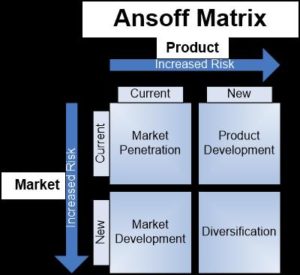
Middle-market businesses need simple ways to consider strategic market options. A simple and effective, compact tool is the Ansoff matrix, a simple, 2×2 matrix that guides planners in developing options.
Basically, it provides four options that are dependent on two variables: developing new products and entering new markets. Both involve expense and, therefore, risk. They also pose risks to the company brand. Here is a simple way to think of the four options:
Market Penetration-
How do you grow if you sell the same product to the same customers? Consider adjusting the marketing-mix elements: more effective promotion, product improvement and lower pricing. It is the least risky option, but likely to reap limited rewards.
Product Development-
If a company is entrenched in a market with respected products and services, it might be possible to sell that same set of customers other products. This leverages companies’ current market good will and credibility. The risk is going so far afield that customers would not relate the new product with the brand.
Market Development-
This is simply selling the same product to a different market. Brand might not be relevant at all, and the risk, therefore, is higher for companies penetrating a less-understood market.
Diversification-
The risk here is typically greatest: You don’t know that much about your product or the market. The rewards here are potentially substantial, but the failure rate is the highest. It is not uncommon for post-mortem analysis of failures to ask, “What were they thinking?”
My take-away thought for you is this: Obviously, there is a risk/reward equation to consider. My experience is that success is not only a function of a company’s ability to understand and mitigate risk, but also of a company’s being grounded in the potential upside of a business, which, all too often, is overly optimistic.
| Market Penetration- How do you grow if you sell the same product to the same customers? Consider adjusting the marketing-mix elements: more effective promotion, product improvement and lower pricing. It is the least risky option, but likely to reap limited rewards. |
Product Development- If a company is entrenched in a market with respected products and services, it might be possible to sell that same set of customers other products. This leverages companies’ current market good will and credibility. The risk is going so far afield that customers would not relate the new product with the brand. |
| Product Development- If a company is entrenched in a market with respected products and services, it might be possible to sell that same set of customers other products. This leverages companies’ current market good will and credibility. The risk is going so far afield that customers would not relate the new product with the brand. |
Market Development- This is simply selling the same product to a different market. Brand might not be relevant at all, and the risk, therefore, is higher for companies penetrating a less-understood market. |
The basis for this article comes from www.simonbrand.com.


